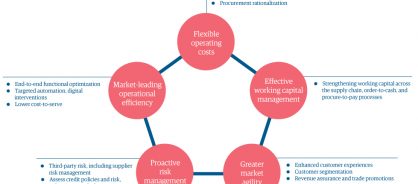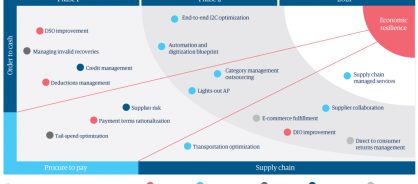- Point of view
Economic resilience: The complete package
Five traits consumer packaged goods and retail businesses must adopt to manage uncertainty and secure a long-term future

As we entered 2020, uncertainty in global trading relationships and falling customer demand signaled a likely recession. Almost overnight, this became a reality when the COVID-19 pandemic created its own raft of economic challenges.
For consumer-packaged-goods (CPG) and retail companies, this meant an immediate need to reconfigure supply chains and adapt to customers' quickly changing shopping habits, revolutionizing how businesses serve their consumers and manage their operations.
As e-commerce has gone mainstream, companies are penetrating previously resistant segments such as baby boomers, who have become comfortable with the channel. Consumer goods companies are also extending their reach by developing new high-volume, low-value direct-to-consumer (D2C) sales channels as demand for essential goods surged while the market for many nonessentials dropped sharply.
Such uncertainty and rapid change have created challenges for supply planning and demand forecasting and put pressure on cash flow and working capital. Businesses have been working to minimize risk until stability returns.
To help organizations manage today's obstacles and build a long-term future, we have identified the five characteristics of economic resilience commonly shared by companies that compete and thrive in challenging times (see figure 1).
To examine how CPG and retail companies can reinvent their businesses to thrive in the future, we explore how to start applying these traits today to become an agile, insight-focused, prosperous organization.
Figure 1: The five traits of economic resilience

1. Effective working capital management – cash is king
During times of economic turmoil, the priority for CPG and retail businesses has always been to weatherproof the ship, conserving cash to prepare for greater volatility in consumer demand. And though food and beverage and personal care manufacturers and retailers are managing spikes in demand, the consumer-durables sector (such as home goods and apparel) has faced a subdued demand outlook.
Effective cash flow management coordinates action across three fundamentals: payables, receivables, and inventory performance. For example:
- Levers such as a dynamic collections strategy and improved credit monitoring and deductions management improve days sales outstanding (DSO)
- Addressing supplier payment terms, strengthening your supplier base, and taking advantage of early payment discounts improve days payable outstanding (DPO)
- Creating greater inventory transparency, enhancing supply and demand planning, and rationalizing product portfolios lower days inventory outstanding (DIO)
Putting digital to work
Digital technologies can have a dramatic impact. Automating invoicing and collections processes will improve DSO and minimize disputes. Even a simple innovation like adding a QR code to invoices can help eliminate the cost of data entry and manual errors.
Technology can ensure you don't miss early payment discount windows. And payment analytics can identify the best use of capital – so you know whether to pay early for a discount or keep money in the bank – to enhance DPO.
Revenue and cost leakage can also occur if promotions were not executed accurately. And on the procurement side: are vendors charging the contracted amount? Are there outstanding credits you can collect? Technology can provide the transparency that eludes many firms.
There's also a need to improve access to real-time data and metrics. Organizations that have invested in robotic-process automation (RPA), dashboard reporting technology, and data warehousing have greater visibility of their cash and associated metrics and can manage working capital more effectively.
Further reading: Six ways your finance operations can unlock cash
Case study
A global apparel manufacturer was suffering from revenue dilution caused by fragmented strategies and processes and disparate legacy systems. The impact was affecting working capital.
By redesigning collections and deductions processes, including prioritizing customers based on their type and behaviors, digitizing all paper invoices and automating workflows, we reduced DSO from 79 to 48 days.
This enabled the company to generate $124 million in cash flow and gained $7.4 million in interest savings.
2. Market-leading operational efficiency – using data to optimize operations
Adaptability is key to responding to economic volatility. But at many established CPG and retail companies, supply chains are still inefficient and inflexible compared to digital giants like Amazon. Your organization must also use data and technology to standardize and streamline end-to-end processes across supply chain, finance, and procurement functions to reap rewards for customers, suppliers, and the business. And more granular insights will determine when to rationalize SKUs to meet demand spikes or cut costs where it has fallen.
Organizations with robust automation and analytical capabilities that can connect disparate data across their ecosystem can automate 20–40% of supply chain tasks. And with analytics, they're also improving demand forecasts, uncovering end-to-end insights, and making more informed investment decisions.
Organizations should continuously refine their operations, drive out complexity, harmonize plans, and build agility. That might mean partnering with technology companies and service providers rather than developing in-house capabilities.
A robust data strategy is crucial. Companies need the right information – from both internal and external sources – to identify operational inefficiencies and make better decisions. Accurate insights and forecasts for supply and demand planning and performance will help CPG and retail businesses stay ahead of disruption.
Case study
A global snack food company wanted to transform its business model to meet rising customer expectations and competition. We helped the company reimagine its operations, standardize 150 global processes, and embed digital technologies in its back-office functions.
As a result, the organization improved governance and resilience, accelerated time to market, and reinvested savings in innovation to drive growth while reducing the cost of finance operations by more than 40%.
3. Proactive risk management – plan ahead to mitigate risk
Economic uncertainty increases the need for greater risk awareness and stronger mitigation capabilities. Sound credit-risk management, for example, can help limit revenue leaks, which has a positive impact on income/P&L and cash flow.
A CPG company or retailer needs a flexible supply chain with alternative vendors on hand to prevent interruption should one supplier fail to deliver. By combining data from across the network – including information on capacity and delivery performance – with control-tower solutions or advanced analytics, businesses can assess specific risk scenarios and execute corrective action.
These scenarios must now also consider new variables such as public health systems and available support infrastructures. And supplier assessments should happen dynamically and regularly rather than just at the initial onboarding stage. During times of disruption, companies can accelerate third-party due diligence by prioritizing the factors they monitor. They should also lower supply chain risk by achieving the best mix of local sourcing and global supply chains.
And to mitigate subsequent spikes in demand from people filling their cupboards due to further COVID-19 outbreaks, companies need to adopt more dynamic demand sensing based on a range of channels – including social media. This approach maintains efficient and sustainable inventory levels.
Other areas to keep in mind are the risks facing logistics networks as they manage greater demands to fulfill the last mile and get products to customers.
Case study
A CPG firm's procurement function was struggling to monitor its global supplier base of more than 50,000 companies and spent significant time and effort reviewing red-flag alerts.
We screened the full list for relevant risk drivers – such as sanctions, anti-bribery and corruption, political exposure, and adverse media, identifying high-risk and medium-risk suppliers – and streamlined red-flag escalations.
This gave the business greater confidence and increased resilience across its global supply chain
4. Flexible operating costs – survival of the most agile
When a crisis strikes, it's not the strongest nor the most intelligent species that survives; it's those that are best at adapting. The same applies to business.
CPG companies typically have operating margins of around 20%, while retailers can work with margins of just 2–5%. But there are steps all companies should take to improve their ability to operate effectively.
CPG brands can make their supply-and-demand predictions more frequent, agile, and robust using forecast analytics and modeling. Instead of looking a quarter ahead, if the process uses broader sets of data and more advanced technologies, it can become more fluid with weekly or even daily reporting.
Retail businesses should focus on driving in-store efficiency by managing inventory levels. And by embracing technology, they can expand the channels available to customers to meet changing behaviors and expectations while rationalizing the company's physical footprint.
Turbulent periods are unrivaled opportunities. Companies should closely monitor the economic trends and pick the initiatives that will benefit from digital transformation, generating insights that win the recovery. Research from McKinsey shows that companies further along the digital journey will realize more than 7% more revenue growth than industry peers.1
Case study
A CPG giant was struggling to satisfy its retailer buyers' needs because of an outdated order-management and fulfillment function.
We developed an intelligent, cloud-based fulfillment analytics solution to get more goods on shelves on time. The solution helps the company manage operational costs and increase sales by filling every truck to capacity and deploying the fleet efficiently. It also generates real-time demand signals and market forecasts for accurate, time-phased inventory planning.
With fewer errors, the business boosted customer satisfaction, reduced the cost to serve, and unlocked revenues of $10 million in Asia-Pacific alone by reducing missed orders by 20%.
5. Market agility around customer needs – the rise of e-commerce and D2C
The e-commerce explosion caused by COVID-19 will change buying habits for good, making the need for first-class digital experiences essential. In the UK, for example, internet sales as a percentage of total retail sales increased from 20.1% in January 2020 to 32.8% in May 2020.2
Companies that have fully embraced this shift will have predictive models in place to detect trends early and provide the right products through the right channels.
Retailers need to roll out new ways to personalize the online shopping experience to stay ahead. That means using analytics at every customer touchpoint to deepen connections and gain real-time insights that create tailored experiences and promotions.
Similarly, ramping up D2C sales is a huge priority for CPG firms. Until now, its proportion of sales in this channel has been small, with companies conscious of the power held by Amazon and Alibaba. But they want to retain control over their brand, customer experience, and data when consumers can't visit stores.
To meet this goal, organizations should address their target operating models to enhance fulfillment channels and last-mile distribution centers. This will include identifying partners and networks for national and local delivery. Companies also face new challenges, such as managing orders, processing returns – which retailers previously handled for them – and recognizing and reconciling revenue streams.
Case study
A global retailer wanted to augment customers' shopping experiences across physical and online channels with end-to-end mobile solutions.
We developed a cross-platform approach for rapid app development that integrated the company's offerings with payment gateways and enhanced the user experience with loyalty programs.
The transformation boosted sales on mobile by 30% and increased revenue potential by using buying-behavior analytics.
Keep on course
To introduce all five economic-resilience characteristics into your business, we've created an illustrative high-level roadmap of potential steps (figure 2). It includes short-term actions and longer-term initiatives that – when combined – will create a more robust, sustainable organization.
Figure 2: A roadmap to economic resilience

For CPG and retail companies, these five characteristics are key. Unlocking working capital to help weather today's uncertain landscape is imperative. The increased focus on liquidity from senior management is another catalyst for digital transformation within businesses that struggle to provide reporting insights at speed.
Creating an agile, flexible supply chain with multiple, more diverse suppliers is also crucial to an organization's long-term resilience. And companies need to adapt to rapidly changing consumer behavior, particularly across buying channels. The companies that adapt to their new environments will rise and thrive, building the resilience they need to face down future uncertainty too.
Learn more about our work with consumer goods and retail companies.